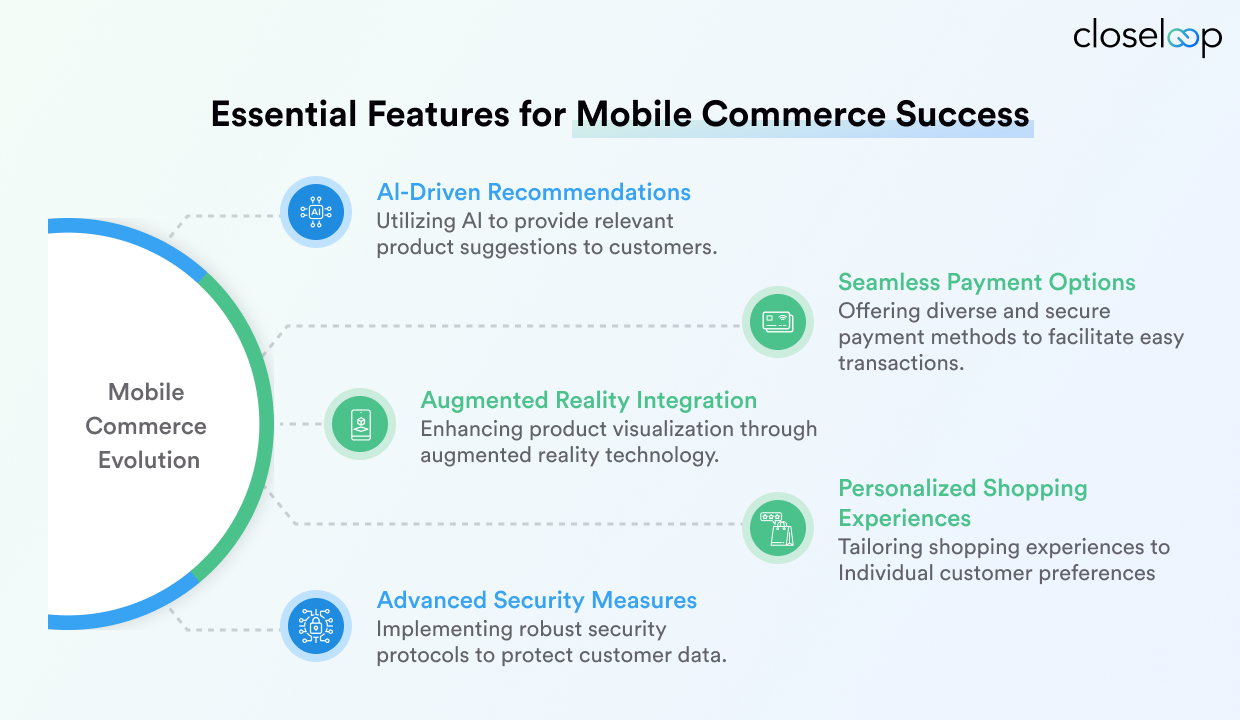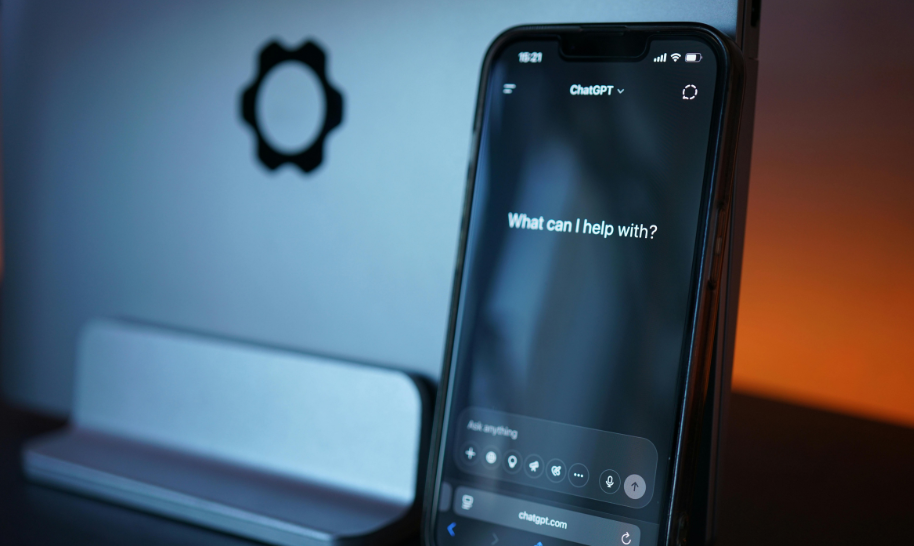Mobile commerce (m-commerce) has undeniably reshaped the retail landscape, transforming smartphones into powerful shopping hubs. As we move further into 2025, the imperative for businesses to optimize their mobile presence with cutting-edge features becomes more critical than ever. With mobile commerce sales projected to reach an astounding $710 billion by the end of 2025, accounting for 44% of total e-commerce sales, according to Tidio, the mobile channel is no longer just an option—it's the primary battleground for customer engagement and revenue.
While mobile's share of e-commerce continues to grow, conversion rates on mobile still lag behind desktop (Tidio reports 2% for mobile vs. 3% for desktop). This gap highlights a significant opportunity: by implementing the right features, businesses can convert more mobile browsers into buyers. This guide will explore the top mobile commerce features poised to boost your sales in 2025, from AI-driven personalization and seamless checkout experiences to immersive AR/VR and the power of social commerce, ensuring your mobile strategy is future-ready and highly profitable.
Key Takeaways
AI-powered personalization significantly boosts user engagement, conversions, and customer retention.
Voice commerce is becoming mainstream with smart assistant compatibility and hands-free shopping.
One-click checkout and digital wallet integrations reduce friction and cart abandonment.
Augmented Reality (AR) elevates buyer confidence through immersive try-before-you-buy experiences.
Progressive Web Apps (PWAs) offer fast, offline-capable, app-like performance on mobile browsers.
Social commerce enables in-app shopping on Instagram, TikTok, and Pinterest, driven by influencers.
Implementing these features with expert guidance from Closeloop ensures long-term growth and scalability.
The State of Mobile Commerce in 2025
Mobile commerce is no longer just a convenient extension of online shopping—it’s becoming the primary mode of e-commerce engagement across the globe. As smartphones become smarter and more integrated into daily life, consumer behavior is rapidly shifting toward mobile-first transactions. The year 2025 is poised to be a defining moment for businesses embracing this mobile evolution.
Mobile Commerce by the Numbers
Explosive Revenue Growth
According to Statista, global mobile e-commerce sales reached $2.2 trillion in 2023, accounting for nearly 60% of all online shopping. This figure is expected to rise dramatically, with Cropink forecasting that m-commerce sales could hit $6.5 trillion this year. This growth underscores a critical shift in how consumers interact with digital storefronts—favoring mobility, immediacy, and ease of access.

Dominance in Online Orders
The dominance of mobile is also evident in traffic and order data. In Q1 2023, smartphones accounted for 63% of all online shopping orders, as reported by Octal IT Solution. Moreover, by the end of 2025, mobile commerce is projected to represent 75% of total e-commerce sales, solidifying its position as the backbone of online retail.
Regional Trends and Market Insights
Asia-Pacific Leading the Charge
The Asia-Pacific region, particularly China, continues to lead global m-commerce growth. High smartphone penetration, advanced mobile payment infrastructure, and digitally native consumer behavior make this region a key driver of worldwide m-commerce sales.
North America’s Rapid Acceleration
North America isn’t far behind. The region has shown a 17% year-over-year increase in mobile shopping, indicating a steady shift among U.S. and Canadian consumers toward mobile-first behavior. This includes everything from browsing and product discovery to in-app purchases and post-sale support.
Evolving User Behavior in Mobile Commerce
Time-Saving as a Primary Driver
Consumers value efficiency. In fact, 76% of mobile users shop on their phones because it saves time, especially during daily commutes, breaks, or multitasking moments. Convenience has become the cornerstone of mobile shopping appeal.
Price Comparison and In-Store Engagement
Another interesting behavioral trend is the use of smartphones as in-store shopping companions. Nearly 49% of mobile users compare product prices on their phones while shopping in physical stores. This trend shows how mobile commerce enhances offline retail by empowering real-time decision-making.
Mobile Apps Overtaking Mobile Web
A significant shift is also visible in the platform of choice. According to Tidio, 73% of online shoppers prefer mobile apps over websites due to better user experience, saved preferences, and faster checkouts. Even more telling, 83% of consumers use a shopping app while physically inside a store, blurring the lines between digital and in-person commerce.
Digital Payments on the Rise
The Surge of Mobile Wallets
Mobile wallets like Apple Pay, Google Pay, Paytm, and WeChat Pay are reshaping how people pay. Mobile wallets are now responsible for an estimated 60% of global digital transactions, offering secure, fast, and contactless payment options that appeal to modern consumers.
App Usage Growth Continues
The growth in shopping app usage also reflects increased mobile dependence. From 2023 to 2024, there was a 54% surge in shopping app usage, pointing to consumer preference for tailored, app-based experiences rather than generic web browsing.
Must-Have Mobile Commerce Features to Boost Sales in 2025
Mobile commerce continues evolving at breakneck speed, requiring businesses to implement strategic features that genuinely improve customer experience and drive measurable results. The following 15 features represent proven strategies that successful companies are using to increase conversion rates, reduce cart abandonment, and build sustainable competitive advantages in today's crowded digital marketplace.

1. AI-Powered Personalization
AI-powered personalization revolutionizes mobile commerce by delivering tailored shopping experiences that resonate with individual users. By leveraging machine learning algorithms, businesses analyze user behavior, purchase history, and preferences to curate product recommendations and dynamically adjust homepages in real-time. This approach ensures that customers see relevant products and content, increasing engagement and conversion rates. Personalized experiences make users feel valued, fostering loyalty and encouraging repeat purchases.
For instance, AI can predict a user’s style preferences or suggest complementary products, reducing decision fatigue and enhancing satisfaction. As mobile shoppers demand seamless, customized interactions, AI personalization becomes a cornerstone for boosting sales and retention in 2025.
Amazon: Uses AI to generate product recommendations, accounting for 35% of its revenue through tailored suggestions based on browsing and purchase history.
Stitch Fix: Employs AI to curate clothing boxes, matching items to user style profiles and preferences.
ASOS: Features dynamic homepages that adapt to user demographics, showcasing trending items tailored to individual tastes.
2. Voice Commerce Integration
Voice commerce integration enables users to search for products and complete purchases using voice commands, offering unparalleled convenience. Compatible with assistants like Siri, Alexa, and Google Assistant, this feature caters to multitasking consumers and those with accessibility needs.
Voice search simplifies product discovery by allowing natural language queries, while voice-activated purchases streamline reordering for frequently bought items. As voice technology improves, its adoption in mobile commerce grows, providing a hands-free shopping experience that saves time and enhances user satisfaction, ultimately driving sales.
Walmart: Supports voice-ordered grocery restocking via Google Assistant, simplifying repeat purchases.
Domino’s Pizza: Allows customers to reorder favorites using Alexa, speeding up the ordering process.
Target: Integrates Siri for voice-based product searches, enhancing accessibility on its mobile app.
3. One-Click Checkout & Digital Wallets
One-click checkout and digital wallet integration, such as Apple Pay and Google Pay, streamline the payment process, significantly reducing cart abandonment. By securely storing payment information, these systems enable users to complete purchases with a single tap, catering to the mobile shopper’s need for speed.
This frictionless experience is critical for capturing impulse buys and ensuring conversions, as lengthy checkout processes often deter customers. By prioritizing simplicity and security, businesses can boost trust and increase sales, making one-click checkout a must-have feature for 2025.
Shopify: Offers one-tap checkout, reducing cart abandonment rates by up to 20% for merchants.
Nike: Integrates Apple Pay for seamless, secure mobile transactions, enhancing user convenience.
PayPal’s One Touch: Enables instant checkout across multiple platforms, improving conversion rates.
4. Augmented Reality for Product Visualization
Augmented reality (AR) transforms mobile commerce by allowing customers to visualize products in their real-world environment before purchasing. From trying on virtual clothing to placing furniture in a room, AR provides a try-before-you-buy experience that bridges the gap between online and in-store shopping.
This technology reduces uncertainty, lowers return rates, and boosts buyer confidence by offering an interactive, immersive experience. As AR becomes more accessible on mobile devices, its adoption in 2025 will drive engagement and sales for industries like fashion, home decor, and cosmetics.
IKEA Place: Enables users to visualize furniture in their homes using AR, improving purchase confidence.
Sephora’s Virtual Artist: Lets customers try makeup virtually via their phone cameras, enhancing decision-making.
Warby Parker: Offers AR-based eyeglass try-ons, ensuring proper fit and style selection.
5. Progressive Web Apps (PWAs)
Progressive Web Apps (PWAs) deliver app-like experiences without the need for app store downloads, offering faster performance, offline access, and reduced data usage. PWAs load quickly, even on low-bandwidth networks, ensuring a seamless shopping experience.
Their lightweight nature and ability to work offline make them ideal for reaching diverse audiences, including those in emerging markets. By combining the best of web and mobile apps, PWAs enhance user engagement and retention, making them a critical feature for mobile commerce in 2025.
Starbucks: Uses a PWA for offline menu browsing and order placement, improving accessibility.
Pinterest: Increased user engagement by 60% with its PWAs’ fast load times and app-like interface.
Flipkart: Leverages a PWA to deliver a seamless shopping experience to millions in India.
6. Social Commerce Integration
Social commerce integration allows users to shop directly on platforms like Instagram, TikTok, and Pinterest, capitalizing on social media’s influence. By embedding shoppable posts and influencer-led product showcases, businesses tap into impulse buying trends and reach younger audiences. This seamless integration shortens the purchase journey, as users can buy without leaving their favorite apps. As social platforms evolve into commerce hubs, social commerce will be a game-changer for driving sales in 2025.
Instagram Shop: Enables direct purchases from posts and stories, streamlining the shopping process.
TikTok Shop: Combines influencer product demos with in-app buying, boosting conversions.
Pinterest: Offers buyable pins, allowing users to shop curated products instantly.
7. Push Notifications with Dynamic Offers
Push notifications with personalized, location-based, or time-sensitive offers re-engage users and create urgency. By delivering tailored promotions at the right moment, businesses can drive immediate action, such as completing a purchase or revisiting an abandoned cart.
These notifications leverage data on user preferences and behavior to maximize relevance, ensuring higher click-through rates. In 2025, dynamic push notifications will be essential for maintaining customer interest and boosting sales.
Zara: Sends location-based notifications for nearby store discounts, encouraging in-store visits.
Uber Eats: Uses time-sensitive deal notifications to prompt immediate food orders.
Sephora: Alerts users about restocked favorites via personalized push notifications.
8. Loyalty Programs and Gamification
Loyalty programs combined with gamification, such as points, badges, or spin-the-wheel offers, incentivize repeat purchases and enhance engagement. By turning shopping into an interactive experience, businesses foster emotional connections with customers, encouraging long-term loyalty. Gamified rewards make the shopping process enjoyable, driving retention in a competitive market. In 2025, these mechanics will be crucial for building strong customer relationships and increasing sales.
Starbucks Rewards: Awards points per purchase, redeemable for free drinks or food items.
Revolve: Uses gamified badges for frequent shoppers, encouraging repeat purchases.
AliExpress: Offers spin-the-wheel discounts during checkout, boosting engagement.
9. In-App Chatbots & Virtual Shopping Assistants
In-app AI chatbots and virtual shopping assistants provide instant support, answering product queries, recommending items, and tracking orders in real-time. Powered by AI, these tools offer 24/7 assistance, reducing response times and improving customer satisfaction. By guiding users through the buying process, they enhance trust and streamline decision-making, making them indispensable for mobile commerce in 2025.
H&M: Uses a chatbot for style recommendations and order status updates.
Best Buy: Employs a virtual assistant to compare tech products within its app.
eBay: Leverages AI chatbots to resolve customer queries, reducing support ticket volume.
BOOK A DEMO: Custom Generative AI Chatbot Solution
10. Seamless Omnichannel Experience
A seamless omnichannel experience syncs user preferences, shopping carts, and purchase history across mobile apps, websites, and physical stores. This cohesive approach ensures customers can switch devices or channels without losing context, enhancing convenience and trust. By providing a unified shopping journey, businesses improve customer satisfaction and drive repeat purchases, making omnichannel integration vital for 2025.
Target: Syncs carts across its app, website, and stores for a seamless experience.
Walmart: Offers in-store pickup for online orders, integrated via its mobile app.
Nordstrom: Ensures wishlists are consistent across all channels, boosting user convenience.
11. Advanced Search and Filtering with Visual Recognition
Advanced search and filtering with AI-based visual recognition simplify product discovery. Users can upload images to find similar items or use intuitive filters for size, color, or price, reducing search time. These tools cater to mobile shoppers’ need for efficiency, enhancing the user experience and increasing conversion rates. In 2025, advanced search capabilities will be critical for standing out in crowded markets.
ASOS: Integrates Google Lens for visual searches, matching user-uploaded images to products.
Amazon: Offers visual search to find items based on user photos, streamlining discovery.
Zalando: Provides advanced filters for precise product searches, improving usability.
12. Real-Time Inventory and Delivery Tracking
Real-time inventory and delivery tracking offer transparency, displaying stock availability and order status updates. This builds trust by reducing uncertainty and keeping customers informed throughout the purchase journey. By providing accurate, up-to-date information, businesses enhance buyer confidence and satisfaction, driving loyalty and sales in 2025.
Amazon: Shows real-time stock levels and delivery estimates for all products.
FedEx: Integrates tracking into retailer apps like Walmart for live order updates.
Zara: Displays in-store and online inventory, aiding purchase planning.
ALSO READ: Why Real-time tracking apps are critical for modern operations
13. Subscription Models & Auto-Reordering
Subscription models and auto-reordering streamline repeat purchases for consumables like groceries or personal care items. By automating reordering based on user preferences, businesses ensure convenience and consistent revenue. These models enhance retention by simplifying the shopping process, making them a key feature for mobile commerce in 2025.
Dollar Shave Club: Delivers razors on a subscription basis with auto-reordering options.
Amazon Subscribe & Save: Automates restocking of household essentials, offering discounts.
HelloFresh: Provides meal kit subscriptions, simplifying weekly meal planning.
14. Sustainability & Ethical Product Filters
Sustainability and ethical product filters empower eco-conscious shoppers to prioritize products based on environmental impact or ethical sourcing. As consumer demand for responsible brands grows, these filters build trust and attract values-driven buyers. By highlighting sustainable options, businesses differentiate themselves and drive sales among environmentally aware customers in 2025.
ASOS: Features a “Responsible Edit” filter for sustainable fashion choices.
Patagonia: Highlights eco-friendly products with detailed sourcing information in its app.
Etsy: Allows filtering for handmade, sustainable goods, appealing to conscious consumers.
15. In-App Reviews and UGC Integration
In-app reviews and user-generated content (UGC), such as customer photos and videos, build trust and aid decision-making. Verified reviews and authentic user content provide social proof, reassuring shoppers about product quality. By showcasing real-world experiences, businesses encourage purchases and enhance credibility, making UGC integration essential for 2025.
Amazon: Displays verified reviews with user-uploaded photos for product transparency.
Sephora: Showcases customer makeup looks via UGC, inspiring purchases.
Yelp: Integrates user reviews and photos, influencing buying decisions.
Best Practices for Implementing Mobile Commerce Features
Succeeding in mobile commerce requires a strategic approach to feature implementation. In 2025's competitive landscape, businesses should prioritize AI-driven personalization, voice commerce capabilities, and augmented reality experiences to increase conversions and improve customer satisfaction. Here are some of the best practices you can’t ignore
Conducting User Research and UX Audits
Robust user research is the foundation of successful feature implementation. Employ methods like surveys, focus groups, and in-app analytics to gather insights into customer preferences, behaviors, and pain points.
For example, analyzing user journeys can reveal why shoppers abandon carts during checkout. Complement this with UX audits using tools like heatmaps, session recordings, and usability testing to pinpoint friction points, such as confusing navigation or slow-loading product pages.
Regularly updating personas and journey maps ensures features like one-click checkout or dynamic homepages align with evolving user expectations, driving engagement and conversions. Continuous research keeps businesses agile, adapting to shifting trends like the rise of voice commerce.
Prioritizing Features Based on Business Goals
Feature prioritization must align with specific business objectives, such as increasing conversion rates, reducing churn, or targeting new demographics. Use data-driven frameworks like MoSCoW (Must-have, Should-have, Could-have, Won’t-have) or weighted scoring models to evaluate features based on impact, cost, and feasibility.
For instance, a fashion retailer aiming to reduce returns might prioritize AR visualization, while a grocery platform focuses on subscription models for repeat purchases. Engage stakeholders to align feature selection with strategic goals, ensuring resources are allocated efficiently. Regularly reassess priorities to adapt to market changes, such as growing demand for sustainability filters, maximizing ROI, and competitive advantage.
A/B Testing Before Full Rollouts
A/B testing is critical to validate feature effectiveness and minimize risks. Test variations of features, such as different push notification timings or checkout flow designs, on small user segments to compare performance metrics like click-through rates, conversion rates, or time spent in-app.
For example, testing a one-click checkout versus a multi-step process can reveal which reduces cart abandonment. Use tools like Optimizely or Firebase to run experiments and analyze results. Iterative testing ensures features like personalized recommendations resonate with users before full deployment, optimizing performance and user satisfaction while avoiding costly missteps.
Ensuring App Speed, Security, and Accessibility
A high-performing, secure, and accessible app is non-negotiable for mobile commerce success. Optimize speed by minimizing code bloat, leveraging Progressive Web Apps (PWAs), and using content delivery networks (CDNs) to ensure fast load times, even on low-bandwidth networks.
Security measures, such as end-to-end encryption for digital wallets and compliance with PCI DSS standards, build user trust. Accessibility ensures inclusivity, incorporating features like voice commerce compatibility for visually impaired users or screen-reader support per WCAG 2.1 guidelines. Regular performance monitoring and security audits prevent vulnerabilities, ensuring a seamless experience across diverse devices and user needs.
Iterative Feedback Integration
Post-launch feedback is essential for refining features. Implement in-app surveys, ratings, and review prompts to gather user insights on features like chatbots or social commerce integration.
For example, feedback on virtual assistant interactions can improve response accuracy and relevance. Analyze qualitative and quantitative data to identify areas for enhancement, such as streamlining search filters based on user complaints. Continuous iteration through agile development cycles ensures features remain user-centric, adapting to feedback and boosting long-term engagement and retention.
Scalable Infrastructure Planning
A robust infrastructure is vital to support resource-intensive features like real-time inventory tracking or AI-driven personalization. Design systems with cloud-based solutions, such as AWS or Azure, to handle traffic spikes during peak shopping periods like Black Friday. Implement load balancing and caching to maintain performance under heavy usage.
For instance, ensure APIs for delivery tracking scale seamlessly to avoid latency. Regular stress testing and capacity planning prevent downtime, ensuring features perform reliably and support business growth in 2025’s competitive market.
How Closeloop Can Help
Closeloop is a California-based trusted technology partner for businesses looking to elevate their mobile commerce strategy in 2025. We specialize in crafting custom m-commerce solutions tailored to diverse industry needs—from fashion and retail to healthcare and B2B marketplaces. Our team brings deep expertise in AI/ML-driven personalization, AR/VR product visualization, Progressive Web App (PWA) development, and seamless API integrations that power next-gen shopping experiences.
With a proven track record of high-conversion, feature-rich mobile app development, we follow an Agile development process that ensures flexibility, faster time-to-market, and continuous iteration. Our UX-first approach guarantees intuitive designs that drive engagement and retention. From initial strategy and prototyping to full-scale development, testing, and post-launch support, Closeloop delivers end-to-end mobile commerce solutions.
Backed by real success stories and measurable outcomes, Closeloop helps businesses future-proof their mobile commerce platforms—turning innovation into revenue.
Conclusion
As mobile commerce continues to reshape the digital retail landscape, businesses must evolve their strategies to stay competitive in 2025 and beyond. The shift toward mobile-first shopping is no longer optional—it’s essential. From AI-driven personalization and voice commerce to one-click checkouts and immersive AR experiences, the right features can dramatically enhance user engagement, boost conversions, and build long-term customer loyalty.
Investing in modern mobile commerce capabilities isn’t just about keeping up with trends—it’s about unlocking measurable ROI. Businesses that prioritize seamless user experiences, cutting-edge technology, and omnichannel integration are better positioned to capitalize on the growing mobile user base.
Now is the time to future-proof your m-commerce platform with the features that matter. Partnering with experienced technology experts like Closeloop can ensure your solution is innovative, scalable, and ready for what’s next. By embracing the right tools and strategies today, you can shape smarter, faster, and more profitable mobile shopping experiences tomorrow.
Start the Conversation
We collaborate with companies worldwide to design custom IT solutions, offer cutting-edge technical consultation, and seamlessly integrate business-changing systems.
Get in TouchUnlock the power of AI and Automation for your business with our no-cost workshop.
Join our team of experts to explore the transformative potential of intelligent automation. From understanding the latest trends to designing tailored solutions, our workshop provides personalized consultations, empowering you to drive growth and efficiency.
Go to Workshop DetailsExplore Our Latest Articles
Stay abreast of what’s trending in the world of technology with our well-researched and curated articles
View More InsightsCost Breakdown to Build a Custom Logistics Software: Complete Guide
Global logistics is transforming faster than ever. Real-time visibility, automation, and AI...
Logistics Software Development Guide: Types, Features, Industry Solutions & Benefits
The logistics and transportation industry is evolving faster than ever. It’s no longer...
From Hurdle to Success: Conquering the Top 5 Cloud Adoption Challenges
Cloud adoption continues to accelerate across enterprises, yet significant barriers persist....
Gen AI for HR: Scaling Impact and Redefining the Workplace
The human resources landscape stands at a critical inflection point. Generative AI in HR has...




